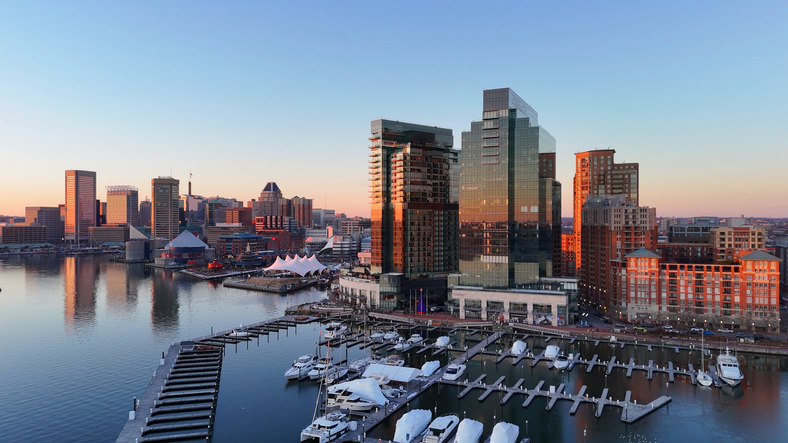The Push To Swim in Baltimore’s Harbor Gains Momentum

The movement to make swimming in Baltimore’s Inner Harbor a reality is going strong. Last year, over 150 people took a plunge to prove the water’s swimmable, followed just two days later by endurance swimmer Katie Pumphrey, who completed a 24-mile journey from the Chesapeake Bay Bridge to the Harbor and loved it so much she’s preparing to do it again.
But new data shows the Harbor may not be as clean as advocates hoped.
Blue Water Baltimore, an environmental nonprofit, released its latest water quality report card this week, revealing a dip in the overall health of the Harbor’s ecosystem. Despite years of infrastructure investments, the Harbor scored just 49% for 2024, a slight decline from the year prior and below expectations, The Baltimore Banner reports.
“It feels like the Red Queen’s race in ‘Through the Looking Glass,’” said Alice Volpitta, Baltimore Harbor Waterkeeper with Blue Water Baltimore. “We’re running fast, but the problems are moving faster.”
Volpitta pointed to ongoing challenges like overdevelopment, sewage overflows, and the growing impacts of climate change. Despite hundreds of millions of dollars spent on stormwater and sewage upgrades, water quality has largely stagnated.
Still, there are bright spots. Levels of dissolved oxygen—essential for aquatic life scored an impressive 93%. Bacteria levels have also improved, helping make the water safer for recreational use. But other indicators tell a different story: chlorophyll, which signals excessive algae growth, scored just 18%, raising concerns about potential toxins and fish kills.
These findings contrast with more optimistic reports from the Waterfront Partnership, the nonprofit leading the “Swimmable Harbor” campaign. Their 2023 “Harbor Heartbeat” report focused on recreational safety rather than ecosystem health. “The Harbor has good days and bad days,” said Adam Lindquist, the group’s vice president, “but we believe the overall trend is positive.”
Lindquist pointed to long-term improvements in dissolved oxygen and nitrogen levels, and confirmed that another public swim event is planned for June. Pumphrey is also preparing for another long-distance swim in the coming days.
But Blue Water’s data shows there’s still work to be done—especially regarding phosphorus, which has worsened over the last decade. In their testing, phosphorus levels in the Harbor and Patapsco River scored just 48%. The pollutant enters the water through sediment, stormwater runoff, industrial waste, and sewage overflows.
One trend that has emerged over the years is a stark contrast between two major Harbor tributaries. The Jones Falls, running north-south through the city, has seen improvements in water quality. But the Gwynns Falls, which flows through West Baltimore, has worsened, with higher levels of pollutants like nitrogen and phosphorus.
Since 2002, Baltimore City and County have invested billions to meet federal environmental standards. The city is still under a consent decree with the EPA, with a revised deadline of 2030 to finish major sewer system upgrades. Baltimore’s Department of Public Works also continues to address compliance issues at the Back River Wastewater Treatment Plant, with a projected total investment of $2.1 billion in water infrastructure improvements by 2032.
“Despite this extraordinary investment, there’s still more to be done,” said Public Works spokesperson Jennifer Combs, noting the need for better land management practices beyond just water treatment.
Volpitta says her role isn’t to tell people whether they should swim—but to provide the facts so they can make informed decisions. And for the Harbor to truly become a clean and safe place to swim, she says, policymakers need to act more aggressively.
“There’s no more time for half-measures,” she said.


